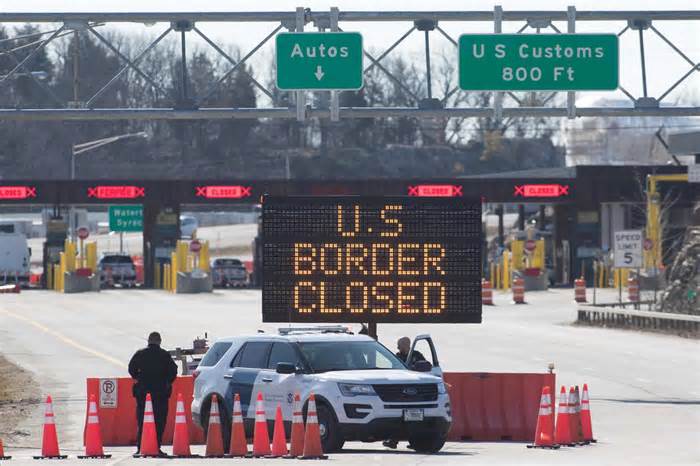When U.S. Sen. Charles Schumer this week called on Canada Border Services Agency officers to use “common sense” when U.S. boaters stray over the line on the St. Lawrence River, Canada’s response was immediate.
“Boaters who enter Canada without reporting to the CBSA (including for the purpose of refuelling) may face severe penalties, including monetary penalties, seizure of their vessels and/or criminal charges,” a spokesperson for the Canadian Minister of Public Safety & Emergency Preparedness told the Times Union.
Then, on Thursday President Trump signed a measure levying new 10% tariffs on Canadian aluminum, a move that drew criticism from both sides of the border.
“Canadian aluminum does not undermine US national security. Canadian aluminum strengthens US national security and has done so for decades through unparalleled cooperation between our two countries,” said Canadian Deputy Prime Minister Chrystia Freeland. “In response to the American tariffs, Canada intends to swiftly impose dollar-for-dollar countermeasures.”
And from the U.S. side: “I oppose the Trump Administration’s decision to reinstate the 10% tariffs on imports of non-alloyed aluminum from Canada,” said U.S. Rep. Elise Stefanik. “The United States and Canada have a strong economic partnership and trading relationship. This decision will slow the rate of our economic recovery from COVID-19, particularly for the manufacturers along the Northern Border in the North Country,” which Stefanik represents.
“This is an unfortunate act of self-harm by the U.S., as past tariffs against Canada have been,” said Garry Douglas, president of the North Country Chamber of Commerce. “The U.S. and Canada make things together and this directly increases costs to many of our manufacturers with cross border supply chains that include aluminum goods.
“Just weeks ago, on July 1st, we implemented the new [U.S.-Mexico-Canada Agreement] as a celebration of the enormous importance of the U.S.-Canada economic partnership, and now we are already forgetting the special nature of that partnership,” Douglas added. “Hopefully, this will be short term in nature and will be reconsidered and reversed quickly.”
Are U.S.-Canada relations fraying?
When the Canadian-U.S. border closed to all nonessential travel March 21 as the coronavirus spread worldwide, the move was considered temporary. But the pandemic continues to grow, and the border closure has been extended through Aug. 21.
The economic impact has been felt on both sides. Schumer, in his letter to Canadian border officials, estimated nearly $400 million a year in economic impact in the U.S. from Canadian visitors.
In Lake George, where motel signs welcome Canadian visitors in French and Canadian flags fly, their absence is noticed.
Quebec license plates, once a common site in the village, have disappeared, said Gina Mintzer, who heads the Lake George Regional Chamber of Commerce. She estimates Canadian tourists in a normal summer account for anywhere from 12 to 17 percent of overall business.
They also boost off-season traffic.
“In the spring, we see their spring breakers,” many drawn to the indoor water park that Six Flags operates south of the village. “Around their holidays we see a spike,” she added, citing Canada Day and Boxing Day.
“They’re big shoppers,” Mintzer added.
Douglas believes the border tensions exhibited on the St. Lawrence “are not a reflection of any negativity but instead reflect differences in attitude and approach around public health in the face of the pandemic.
“Canada has been especially uncompromising on the enforcement of border crossing restrictions and has applied a separate two-week quarantine requirement for anyone entering Canada who is not covered by the very limited definitions of essential travelers,” Douglas said. “These are being applied globally by Canada and not just towards the U.S., and have been reinforced by broad public opinion within Canada.”
In New York, Gov. Andrew Cuomo also has been vocal in calling on residents to obey COVID-19 restrictions to the point that major attractions for tourists on both sides of the border — including Six Flags Great Escape in Queensbury, the Saratoga Race Course, and casinos in Schenectady and Saratoga Springs — remain closed.
Meanwhile, the month-to-month extensions of the border closure, without any clear plan in place for an eventual reopening, have frustrated local and elected officials.
“Continuing to extend border restrictions at 30-day intervals is untenable for the communities that have been separated from family and unable to tend to their property for over three months,” a letter signed last month by Congressional members including Stefanik. The letter went to U.S. and Canadian officials.
And while border restrictions intended to limit the spread of the coronavirus enjoy popular support in Canada, “this reality actually reinforces the need for an urgent commitment by both countries to at least begin to plan the eventual way forward at the border, and to engage in an exploration of some modest accommodations in the near terms such as the issue of boating across the Canadian water boundary, perhaps allowing travel to property within say fifty miles of the border, making a greater accommodation for family and so forth,” Douglas said Friday. “Neither country is responding to such calls with anything but the sound of crickets.”

